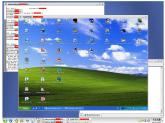

Linux Distribution: A Brief Introduction
Posted by admin in Linux on 03 30th, 2010 | no responses
Chander shekhar Riat asked:
A Linux distribution is also known as the GNU/Linux distribution by some. It is basically a family member of the Unix-like software distributions and these distributions are called “distros”. Linux kernel lies as the basis of these distributions. They contain a number of software applications comprising database applications, media players, spreadsheets and word processors. The Linux operating system consists of the Linux kernel along with a set of utilities and libraries from the GNU and the X Window System for graphic support.
Some Linux distributions may be optimized for size and may not come with X. These use compact alternatives to the GNU utilities, which may include dietlibc, uclibc or busybox. At present, there are more than 300 Linux distributions and many of them are in the active mode. This means that these distributions are being constantly studied, and revised to be improved. The Linux distributions are available in different forms because most of the kernels and supporting packages used are combination of open source and free software. They may take the form of a fully featured desktop or server operating system or can also be used in minimal environments. This is the reason why they are widely used in embedded systems and for things like booting from a floppy disk.
Actually, leaving aside the custom software aspect, the word distribution here simply means a specific assortment of some applications that are installed on top of a set of libraries, along with a version of the kernel. This is created in such a manner that the “out-of-the-box” capabilities are met with most of the requirements of its specific end-user base. There are many kinds of Linux distributions, such as community, corporation and others. The known ones including Fedora (Red Hat), Mandriva Linux, Ubuntu (Canonical Ltd.), and openSUSE (Novell) are backed commercially. The community distributors consist of Gentoo and Debian. The others are driven by neither a community nor a corporation. The most famous one is Slackware.
A basic Linux distribution for desktop consists of a Linux kernel, GNU libraries and tools, documentation, additional software, window manager, a window system and a desktop environment. Most of the software and sources that form a part of this operating system are free software and open source. This means that the users can compile the original code or can modify as per their own needs. Nevertheless, in some cases the software might not be available in the source code form.
Before the Linux distributions came into existence, a would-be Linux user had to be a Unix expert. A would-be user had to be aware of the details about the placement and configuration of the files in that system. This distribution has made the task of using Linux as the operating system easier.
Caffeinated Content for WordPress
A Linux distribution is also known as the GNU/Linux distribution by some. It is basically a family member of the Unix-like software distributions and these distributions are called “distros”. Linux kernel lies as the basis of these distributions. They contain a number of software applications comprising database applications, media players, spreadsheets and word processors. The Linux operating system consists of the Linux kernel along with a set of utilities and libraries from the GNU and the X Window System for graphic support.
Some Linux distributions may be optimized for size and may not come with X. These use compact alternatives to the GNU utilities, which may include dietlibc, uclibc or busybox. At present, there are more than 300 Linux distributions and many of them are in the active mode. This means that these distributions are being constantly studied, and revised to be improved. The Linux distributions are available in different forms because most of the kernels and supporting packages used are combination of open source and free software. They may take the form of a fully featured desktop or server operating system or can also be used in minimal environments. This is the reason why they are widely used in embedded systems and for things like booting from a floppy disk.
Actually, leaving aside the custom software aspect, the word distribution here simply means a specific assortment of some applications that are installed on top of a set of libraries, along with a version of the kernel. This is created in such a manner that the “out-of-the-box” capabilities are met with most of the requirements of its specific end-user base. There are many kinds of Linux distributions, such as community, corporation and others. The known ones including Fedora (Red Hat), Mandriva Linux, Ubuntu (Canonical Ltd.), and openSUSE (Novell) are backed commercially. The community distributors consist of Gentoo and Debian. The others are driven by neither a community nor a corporation. The most famous one is Slackware.
A basic Linux distribution for desktop consists of a Linux kernel, GNU libraries and tools, documentation, additional software, window manager, a window system and a desktop environment. Most of the software and sources that form a part of this operating system are free software and open source. This means that the users can compile the original code or can modify as per their own needs. Nevertheless, in some cases the software might not be available in the source code form.
Before the Linux distributions came into existence, a would-be Linux user had to be a Unix expert. A would-be user had to be aware of the details about the placement and configuration of the files in that system. This distribution has made the task of using Linux as the operating system easier.
Caffeinated Content for WordPress
Related Posts

No Comments »
No comments yet.
RSS feed for comments on this post. TrackBack URL












